
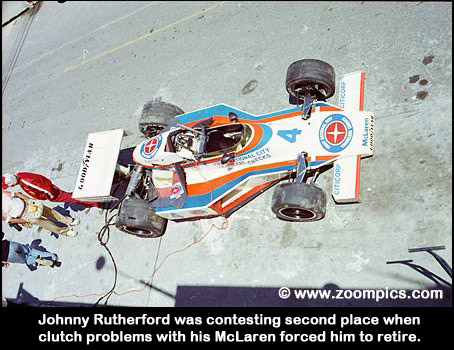 The 1978 United States Auto Club
(USAC) National Championship was an eighteen-race series for the organization's premier
class - Championship Cars (Champ Cars). The series was at one of the high points
during its 22-year history. The popularity of the championship could be attributed to
several of factors. First, the series included USAC's prestigious triple crown - the
Indy 500, the Schaefer 500 at Pocono, Pennsylvania and the California 500 at Ontario
Motor Speedway - events well known not only to race fans but the general public. Also,
the series included drivers that were household names in North America. Among them was
four-time Indy 500 winner A.J. Foyt, two-time USAC and Indy 500 champion Bobby Unser
and Danny Ongais the 1977 USAC rookie of the year. Other veteran drivers included
former Indy 500 winners Al Unser and Johnny Rutherford. Popularity was also bolstered
by the growth of motor sport coverage on television during the '70s. The opportunity
for increased exposure was not lost on corporate America, who recognized the value of
investing their advertising money in racing. Finally, many have suggested that the
strength of the series and organization lay in the strong guidance provided by Dick
King the President and Director of Competition for USAC.
The 1978 United States Auto Club
(USAC) National Championship was an eighteen-race series for the organization's premier
class - Championship Cars (Champ Cars). The series was at one of the high points
during its 22-year history. The popularity of the championship could be attributed to
several of factors. First, the series included USAC's prestigious triple crown - the
Indy 500, the Schaefer 500 at Pocono, Pennsylvania and the California 500 at Ontario
Motor Speedway - events well known not only to race fans but the general public. Also,
the series included drivers that were household names in North America. Among them was
four-time Indy 500 winner A.J. Foyt, two-time USAC and Indy 500 champion Bobby Unser
and Danny Ongais the 1977 USAC rookie of the year. Other veteran drivers included
former Indy 500 winners Al Unser and Johnny Rutherford. Popularity was also bolstered
by the growth of motor sport coverage on television during the '70s. The opportunity
for increased exposure was not lost on corporate America, who recognized the value of
investing their advertising money in racing. Finally, many have suggested that the
strength of the series and organization lay in the strong guidance provided by Dick
King the President and Director of Competition for USAC.
|
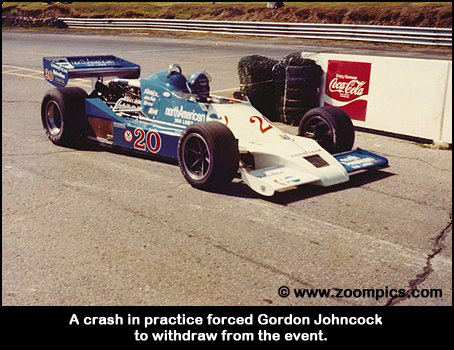 The cars during this season were
a mixture of American and British-built chassis. American designers and constructors
introduced several new cars in 1978. Mini-Indy series champion, Tom Bagley, used a
Watson constructed by the legendary "roadster" builder, A.J. Watson. The Patrick
Racing Team included a pair of George Bignotti's new Wildcats for Gordon Johncock and
Steve Krisiloff. Constructor Lindsey Hopkins and designer Roman Slobodynskj created
Lightnings for Johnny Parsons and Pancho Carter. Bobby Unser contested the season in
an Eagle out of Dan Gurney's Santa Ana, California shop. Finally, the Penske team had
new PC-6s for Rick Mears and Tom Sneva. However, there was a trend developing which
saw teams adopting the British built cars. Jim Hall had a pair of Lolas created and
badged as Chaparrals for Al Unser. A new McLaren M-24 was driven by two-time Indy
500 winner, Johnny Rutherford. The engine rules for 1978 permitted the use of four
different configurations. Stock block motors were eligible with a displacement of 5.8-
litres if naturally aspirated or 3.4-litres if turbocharged. Teams could also use
naturally aspirated race engines of 4.5-litres or turbocharged 2.7-litre motors.
Although many of these configurations were tested the popular choices were the
venerable 4-cylinder turbocharged Drake Offy or the recently developed turbocharged
Cosworth DFX V-8. These turbocharged methanol powered engines produced approximately
950-horsepower. Unfortunately, the ability to put this power to the track was limited
by narrow wheels and tires. The rules restricted the cars to 15-inch diameter rims
with a maximum width of 10-inches on the front and 12-inches on the rear. In
comparison, a 1978 Formula 1 car used 19-inch wide rear wheels. The minimum weight
for the cars was dependent on the engine design and ranged from 1,425 to 1,500-pounds.
The cars during this season were
a mixture of American and British-built chassis. American designers and constructors
introduced several new cars in 1978. Mini-Indy series champion, Tom Bagley, used a
Watson constructed by the legendary "roadster" builder, A.J. Watson. The Patrick
Racing Team included a pair of George Bignotti's new Wildcats for Gordon Johncock and
Steve Krisiloff. Constructor Lindsey Hopkins and designer Roman Slobodynskj created
Lightnings for Johnny Parsons and Pancho Carter. Bobby Unser contested the season in
an Eagle out of Dan Gurney's Santa Ana, California shop. Finally, the Penske team had
new PC-6s for Rick Mears and Tom Sneva. However, there was a trend developing which
saw teams adopting the British built cars. Jim Hall had a pair of Lolas created and
badged as Chaparrals for Al Unser. A new McLaren M-24 was driven by two-time Indy
500 winner, Johnny Rutherford. The engine rules for 1978 permitted the use of four
different configurations. Stock block motors were eligible with a displacement of 5.8-
litres if naturally aspirated or 3.4-litres if turbocharged. Teams could also use
naturally aspirated race engines of 4.5-litres or turbocharged 2.7-litre motors.
Although many of these configurations were tested the popular choices were the
venerable 4-cylinder turbocharged Drake Offy or the recently developed turbocharged
Cosworth DFX V-8. These turbocharged methanol powered engines produced approximately
950-horsepower. Unfortunately, the ability to put this power to the track was limited
by narrow wheels and tires. The rules restricted the cars to 15-inch diameter rims
with a maximum width of 10-inches on the front and 12-inches on the rear. In
comparison, a 1978 Formula 1 car used 19-inch wide rear wheels. The minimum weight
for the cars was dependent on the engine design and ranged from 1,425 to 1,500-pounds.
|
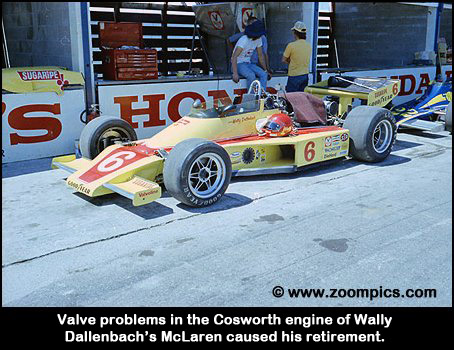 Mosport was the sixth round of
the 1978 National Championship. The track hosted its first USAC Champ Car race during
Canada's Centennial year - 1967. The event was run as two 200-mile heats with Bobby
Unser winning both races. The cars returned in 1968 using the same format. This time
it was Dan Gurney capturing both heats. The series would not return until 1977 -
making the track the only road course in the championship. The winner that year was
A.J. Foyt in his Coyote/Ford. In 1978 three road courses were added to the calendar -
Mosport and Brands Hatch and Silverstone in England. This was the beginning of a trend
for Indy cars that would see more road courses and fewer ovals on the schedule. The
race weekend also included USAC's Mini-Indy (a development class using Super Vees) and
Stock Car divisions. Mosport was the only racetrack during the 1978 season to host all
three divisions on the same weekend.
Mosport was the sixth round of
the 1978 National Championship. The track hosted its first USAC Champ Car race during
Canada's Centennial year - 1967. The event was run as two 200-mile heats with Bobby
Unser winning both races. The cars returned in 1968 using the same format. This time
it was Dan Gurney capturing both heats. The series would not return until 1977 -
making the track the only road course in the championship. The winner that year was
A.J. Foyt in his Coyote/Ford. In 1978 three road courses were added to the calendar -
Mosport and Brands Hatch and Silverstone in England. This was the beginning of a trend
for Indy cars that would see more road courses and fewer ovals on the schedule. The
race weekend also included USAC's Mini-Indy (a development class using Super Vees) and
Stock Car divisions. Mosport was the only racetrack during the 1978 season to host all
three divisions on the same weekend.
|
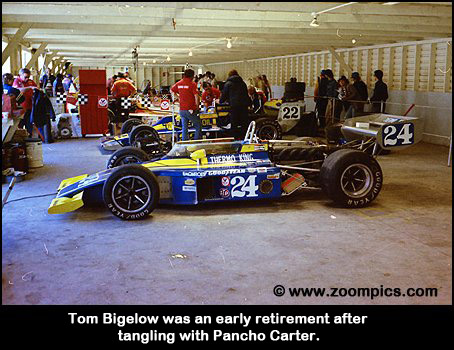 The 1978 season had three
different winners as the teams headed to Mosport. Al Unser won the Indy 500 and Danny
Ongais captured the events at the Ontario Motor Speedway and College Station, Texas.
Gordon Johncock took the opening round at Phoenix and a second win at Trenton, New
Jersey. However, consistent finishes after the opening round of the series allowed
Tom Sneva to lead the championship with 1,725-points. The defending champion had
second place finishes at Indy, California and Texas and a third at Trenton. A close
second in the standings was Johncock with 1,688-points. He was followed by Al Unser
whose tally was 1,325. Fourth at this point in the season was Steve Krisiloff who
could attribute his success to the strategy used by Sneva - consistent finishes.
Rounding out the top five was A.J. Foyt whose best finish thus far was a second at
Trenton. Ongais had been the sensation of the season but his "win at any cost"
driving approach had left him sixth in the standings with 1,075-points just three behind
Foyt.
The 1978 season had three
different winners as the teams headed to Mosport. Al Unser won the Indy 500 and Danny
Ongais captured the events at the Ontario Motor Speedway and College Station, Texas.
Gordon Johncock took the opening round at Phoenix and a second win at Trenton, New
Jersey. However, consistent finishes after the opening round of the series allowed
Tom Sneva to lead the championship with 1,725-points. The defending champion had
second place finishes at Indy, California and Texas and a third at Trenton. A close
second in the standings was Johncock with 1,688-points. He was followed by Al Unser
whose tally was 1,325. Fourth at this point in the season was Steve Krisiloff who
could attribute his success to the strategy used by Sneva - consistent finishes.
Rounding out the top five was A.J. Foyt whose best finish thus far was a second at
Trenton. Ongais had been the sensation of the season but his "win at any cost"
driving approach had left him sixth in the standings with 1,075-points just three behind
Foyt.
|
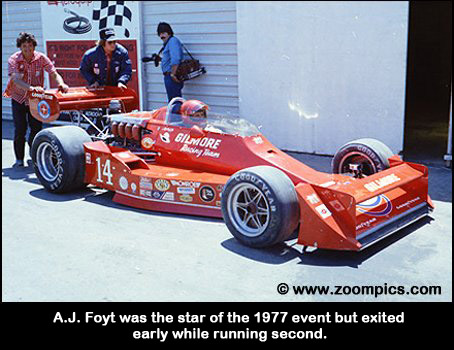 The first practice session was
scheduled for Friday morning at 9:00 am, however, a couple of factors prevented this
from happening. The trouble began when there were not enough marshals to safely
support the corner stations around the 2.459-mile track. This problem was further
compounded when a representative of the FIA, Robert Langford inspected the circuit.
As was the case at the 1977 Canadian Grand Prix the track's safety standards came
under close scrutiny. Langford deemed the track unsafe and would not issue the license
necessary for the cars to compete. After a meeting between Langford, Harvey Hudes,
Mosport's President and Dick King, President and Director of Competition for USAC it
was agreed that the cars would be allowed to practice. Langford said that he would
decide whether he was prepared to issue a license. However, King suggested that
Langford did not have authority over the race because only USAC drivers were competing
in a USAC sanctioned event. He stated that the only way the race would not take place
was if it were to rain. These were not the only problems facing Harvey Hudes this
weekend. Unruly spectators, which seemed to be a common occurrence at major Mosport
events during the '70s, were causing several problems. The trouble began when police
attempted to arrest a man who had rolled his van. In the process, a hostile mob stoned
the police injuring two officers and extensively damaging their cars. The situation
was brought under control and several arrests were made. Another popular pastime at
Mosport and Watkins Glen during the '70s was the burning of vehicles - at least five
cars were torched during the three-day event. On Sunday morning activities were
delayed, as a hole burned in the track at Moss Corner had to be repaired.
The first practice session was
scheduled for Friday morning at 9:00 am, however, a couple of factors prevented this
from happening. The trouble began when there were not enough marshals to safely
support the corner stations around the 2.459-mile track. This problem was further
compounded when a representative of the FIA, Robert Langford inspected the circuit.
As was the case at the 1977 Canadian Grand Prix the track's safety standards came
under close scrutiny. Langford deemed the track unsafe and would not issue the license
necessary for the cars to compete. After a meeting between Langford, Harvey Hudes,
Mosport's President and Dick King, President and Director of Competition for USAC it
was agreed that the cars would be allowed to practice. Langford said that he would
decide whether he was prepared to issue a license. However, King suggested that
Langford did not have authority over the race because only USAC drivers were competing
in a USAC sanctioned event. He stated that the only way the race would not take place
was if it were to rain. These were not the only problems facing Harvey Hudes this
weekend. Unruly spectators, which seemed to be a common occurrence at major Mosport
events during the '70s, were causing several problems. The trouble began when police
attempted to arrest a man who had rolled his van. In the process, a hostile mob stoned
the police injuring two officers and extensively damaging their cars. The situation
was brought under control and several arrests were made. Another popular pastime at
Mosport and Watkins Glen during the '70s was the burning of vehicles - at least five
cars were torched during the three-day event. On Sunday morning activities were
delayed, as a hole burned in the track at Moss Corner had to be repaired.
|
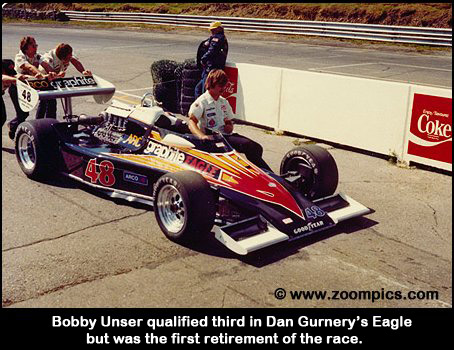 The first practice session
finally got underway over 3-hours after the scheduled start. By the end of the day,
Bobby Unser in the ARCOgraphite Eagle was the fastest with a lap of 1:15.61. Behind
him was his brother Al who turned a 1:16.2 in Jim Hall's Lola Chaparral. Third
quickest was Danny Ongais in the Interscope Parnelli with a time of 1:17.13. Penske
driver, Tom Sneva, was fourth at a 1:18.79. Some of the other competitors did not
fare as well. Gordon Johncock hit the guardrail in turn four with his Wildcat. He
was taken to hospital with a concussion and a suspected broken bone in his left foot.
He would not start the race. Spike Gelhausen crashed in corner three and the damage
to the front end of the car could not be repaired for the race. Next to have an
accident in turn three was Johnny Parsons in his Lightning/Offy. The final victim of
the session was Johnny Rutherford who collected the catch fencing at corner two.
The first practice session
finally got underway over 3-hours after the scheduled start. By the end of the day,
Bobby Unser in the ARCOgraphite Eagle was the fastest with a lap of 1:15.61. Behind
him was his brother Al who turned a 1:16.2 in Jim Hall's Lola Chaparral. Third
quickest was Danny Ongais in the Interscope Parnelli with a time of 1:17.13. Penske
driver, Tom Sneva, was fourth at a 1:18.79. Some of the other competitors did not
fare as well. Gordon Johncock hit the guardrail in turn four with his Wildcat. He
was taken to hospital with a concussion and a suspected broken bone in his left foot.
He would not start the race. Spike Gelhausen crashed in corner three and the damage
to the front end of the car could not be repaired for the race. Next to have an
accident in turn three was Johnny Parsons in his Lightning/Offy. The final victim of
the session was Johnny Rutherford who collected the catch fencing at corner two.
|
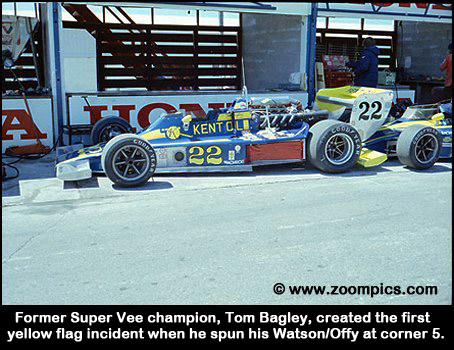 Despite the early speed of the
Unser brothers it was Danny Ongais who captured the pole position Saturday afternoon.
He set a new qualifying record of 1:12.57, which bettered Bobby Unser's lap record set
the previous year of 1:15.44. During the closing stages of the session Ongais felt
there was an opportunity to break the outright lap record of 1:11.385 set by Mario
Andretti during the 1977 Canadian Grand Prix. In his effort to do so he went off at
corner eight and landed in the catch fencing. Despite crashing in this high-speed turn
Ongais was uninjured and the damage to the car was minor. Although he had failed to
establish a new outright lap record he had bettered the fastest race lap set by
Andretti during the Canadian Grand Prix. Qualifying behind Ongais were Al and Bobby
Unser.
Despite the early speed of the
Unser brothers it was Danny Ongais who captured the pole position Saturday afternoon.
He set a new qualifying record of 1:12.57, which bettered Bobby Unser's lap record set
the previous year of 1:15.44. During the closing stages of the session Ongais felt
there was an opportunity to break the outright lap record of 1:11.385 set by Mario
Andretti during the 1977 Canadian Grand Prix. In his effort to do so he went off at
corner eight and landed in the catch fencing. Despite crashing in this high-speed turn
Ongais was uninjured and the damage to the car was minor. Although he had failed to
establish a new outright lap record he had bettered the fastest race lap set by
Andretti during the Canadian Grand Prix. Qualifying behind Ongais were Al and Bobby
Unser.
|
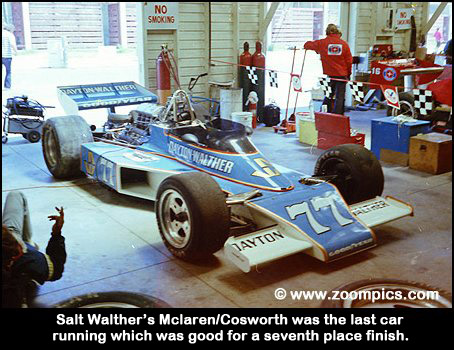 Ongais jumped into the lead and
was followed by Al Unser and the other top qualifiers - Johnny Rutherford and Rick
Mears. Third fastest qualifier Bobby Unser had completed only one lap before his
transmission failed making him the first retirement. By the end of the first lap,
Ongais had a 2.48-second lead over his closest pursuer. Unfortunately, the rash of
accidents that had characterized practice and qualifying carried over to the race.
The first incident involved Tom Bagley who spun his Watson at Moss Corner. He got
going again but his race would come to an end when his oil pump failed on lap
thirteen. Before the race was ten laps old the second yellow appeared for debris -
someone threw a beer bottle on the track. The cars completed only four more circuits
when A.J. Foyt, who was running second, spun and hit the catch fencing at corner two.
Foyt had been one of the pre-race favorites as the result of his 1977 win. Ongais and
Al Unser used the yellow flag situation created by Foyt to pit. This allowed Rick
Mears to take the lead. Again the cars took the green but after only three laps of
racing Tom Bigelow and Pancho Carter collided in turn three. The course was under
yellow for five laps while the wreckage was cleared. During this caution period Rick
Mears made his pit stop, which gave the lead to Al Unser. Unser led for several laps
but on lap thirty-two his day came to an end when he crashed and was unable to
continue. Spectators endured another seven laps of yellow. In fact, twenty-four of
the first thirty-nine laps were completed behind the pace car.
Ongais jumped into the lead and
was followed by Al Unser and the other top qualifiers - Johnny Rutherford and Rick
Mears. Third fastest qualifier Bobby Unser had completed only one lap before his
transmission failed making him the first retirement. By the end of the first lap,
Ongais had a 2.48-second lead over his closest pursuer. Unfortunately, the rash of
accidents that had characterized practice and qualifying carried over to the race.
The first incident involved Tom Bagley who spun his Watson at Moss Corner. He got
going again but his race would come to an end when his oil pump failed on lap
thirteen. Before the race was ten laps old the second yellow appeared for debris -
someone threw a beer bottle on the track. The cars completed only four more circuits
when A.J. Foyt, who was running second, spun and hit the catch fencing at corner two.
Foyt had been one of the pre-race favorites as the result of his 1977 win. Ongais and
Al Unser used the yellow flag situation created by Foyt to pit. This allowed Rick
Mears to take the lead. Again the cars took the green but after only three laps of
racing Tom Bigelow and Pancho Carter collided in turn three. The course was under
yellow for five laps while the wreckage was cleared. During this caution period Rick
Mears made his pit stop, which gave the lead to Al Unser. Unser led for several laps
but on lap thirty-two his day came to an end when he crashed and was unable to
continue. Spectators endured another seven laps of yellow. In fact, twenty-four of
the first thirty-nine laps were completed behind the pace car.
|
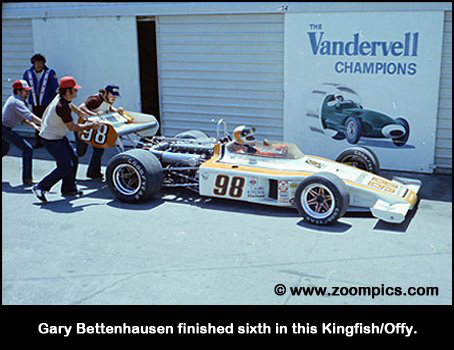 With the retirement of A.J. Foyt,
Al and Bobby Unser most of the serious contenders for the win were out of the race.
Ongais completed the remainder of the race unchallenged. In fact, at one point he
had a 50-second lead over the second place car. He ran a cautious pace probably
remembering last year's event when he was leading and his engine blew. The battle on
the track was now for second between Johnny Rutherford and 1978 Indy 500 rookie of the
year Rick Mears. Unfortunately, Rutherford was forced out of the race on lap
sixty-five with clutch problems. Ongais took the checkered flag after 2 hours, 8
minutes, 38.62 seconds with an average speed of 87.164 miles an hour. His efforts
earned him $28,135 of the $135,229 purse. Finishing just over 40-seconds behind him
was Mears. Through attrition and steady driving ninth fastest qualifier, Steve
Krisiloff was able to capture third place in his Wildcat. Finishing fourth was Tom
Sneva, who was able to pad his point's lead over Johncock. Only seven of the nineteen
starters were running at the finish.
With the retirement of A.J. Foyt,
Al and Bobby Unser most of the serious contenders for the win were out of the race.
Ongais completed the remainder of the race unchallenged. In fact, at one point he
had a 50-second lead over the second place car. He ran a cautious pace probably
remembering last year's event when he was leading and his engine blew. The battle on
the track was now for second between Johnny Rutherford and 1978 Indy 500 rookie of the
year Rick Mears. Unfortunately, Rutherford was forced out of the race on lap
sixty-five with clutch problems. Ongais took the checkered flag after 2 hours, 8
minutes, 38.62 seconds with an average speed of 87.164 miles an hour. His efforts
earned him $28,135 of the $135,229 purse. Finishing just over 40-seconds behind him
was Mears. Through attrition and steady driving ninth fastest qualifier, Steve
Krisiloff was able to capture third place in his Wildcat. Finishing fourth was Tom
Sneva, who was able to pad his point's lead over Johncock. Only seven of the nineteen
starters were running at the finish.
|
| POS. | DRIVER | ENTRANT | CAR | LAPS | RETIREMENTS |
| 1 | Danny Ongais | Interscope | Parnelli/Cosworth | 76 | - |
| 2 | Rick Mears | Gould Charge | Penske PC-6/Cosworth | 76 | - |
| 3 | Steve Krisiloff | Foreman Industries | Wildcat/DGS | 76 | - |
| 4 | Tom Sneva | Norton Spirit | Penske PC-6/Cosworth | 75 | - |
| 5 | Larry Dickson | Polak Construction | McLaren/Cosworth | 75 | - |
| 6 | Gary Bettenhausen | Oberdorfer | King/Offy | 74 | - |
| 7 | Salt Walther | Dayton-Walther | McLaren/Cosworth | 73 | - |
| 8 | Johnny Rutherford | 1st National Traveller's Checks | McLaren/Cosworth | 65 | Clutch |
| 9 | Johnny Parsons | 1st National Traveller's Checks | Lightning/Offy | 51 | Half shaft |
| 10 | Cliff Hucul | Wendy's Hamburgers | McLaren/Offy | 48 | Valve |
| 11 | Wally Dallenbach | Sugaripe Prunes | McLaren/Cosworth | 42 | Valve |
| 12 | Al Unser | 1st National Traveller's Checks | Chaparral/Cosworth | 31 | Accident |
| 13 | Al Loquasto | McCord Auto | Eagle/Offy | 18 | Oil leak |
| 14 | Tom Bigelow | Thermo King | Eagle/Offy | 17 | Accident |
| 15 | Pancho Carter | Budweiser | Lightning/Cosworth | 17 | Accident |
| 16 | A.J. Foyt | Gilmore | Coyote/Foyt | 14 | Accident |
| 17 | Tom Bagley | Kent Oil | Watson/Offy | 13 | Oil pump |
| 18 | Phil Threshie | Machinists Union | Rascar/Offy | 4 | Clutch |
| 19 | Bobby Unser | ARCOgraphite | Eagle/Cosworth | 1 | Transmission |
| DNS | Mike Mosley | Alex Foods | Lightning/Offy | 0 | Accident |
| DNS | Spike Gelhausen | Huber Chevrolet | Eagle/Offy | 0 | Accident |
| DNS | Gordon Johncock | North American Van Lines | Wildcat/DGS | 0 | Accident |
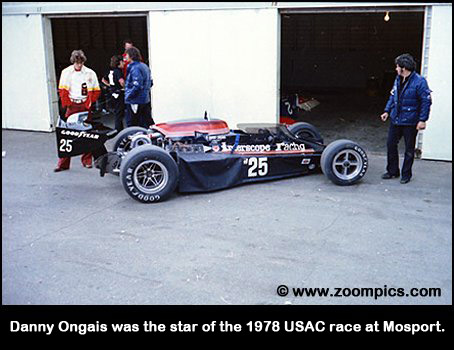 Based on past performances
Ongais' critics had suggested that the only way he could win was if the race was only
ten laps. With so many laps run under the yellow flag their comments weren't too far
off the mark. However, there was no denying Ongais his victory and sometimes you have
to take a win any way you can. But he did have a couple of advantages over the
competition. Ongais had road racing experience at Mosport in both Formula 5000 and
Formula 1 cars. Also the Parnelli he raced was basically a Formula 1 chassis, much
more suited to a road course than some of the other cars which were primarily designed
for ovals. The race at Mosport resulted in some changes in the series standings.
A combination of his consistency and Gordon Johncock's failure to start the race
allowed Sneva to increase his lead in the standings by 277-points - 1,965 to 1,688.
Ongais's win moved him into third in the championship chase with 1,475-points.
The solid run by Steve Krisiloff kept him fourth in the standings but moved him ahead
of Al Unser and closer to Johncock.
Based on past performances
Ongais' critics had suggested that the only way he could win was if the race was only
ten laps. With so many laps run under the yellow flag their comments weren't too far
off the mark. However, there was no denying Ongais his victory and sometimes you have
to take a win any way you can. But he did have a couple of advantages over the
competition. Ongais had road racing experience at Mosport in both Formula 5000 and
Formula 1 cars. Also the Parnelli he raced was basically a Formula 1 chassis, much
more suited to a road course than some of the other cars which were primarily designed
for ovals. The race at Mosport resulted in some changes in the series standings.
A combination of his consistency and Gordon Johncock's failure to start the race
allowed Sneva to increase his lead in the standings by 277-points - 1,965 to 1,688.
Ongais's win moved him into third in the championship chase with 1,475-points.
The solid run by Steve Krisiloff kept him fourth in the standings but moved him ahead
of Al Unser and closer to Johncock.
|
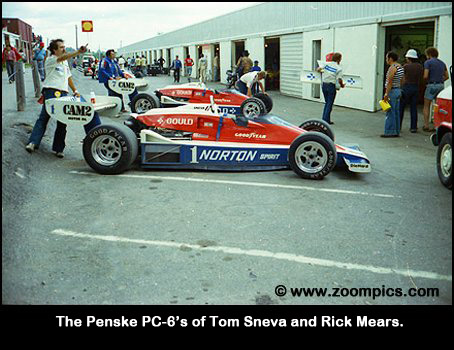 Ongais continued to dominate
the 1978 season and established some impressive statistics in the process. He entered
17 of the 18 races and led 16 of these events. Of the 2,253-laps completed during
the '78 season he led 870 almost 3-times as many as Al Unser (296-laps). Ongais
captured eight-pole positions and five-race wins. Despite these impressive records he
collected only 2,662-points, which left him eighth in the final standings. It appears
that his downfall was finishing races. During the season he only completed 1,704 of
the 2,253-laps (approximately 76%). Some of this can be attributed to bad luck but
his aggressive driving style also contributed to his poor finish in the championship.
Ongais's retirements usually occurred late in the race. Such was the case at Brands
Hatch when a transmission failure forced him to retire on lap-83 of a scheduled 100.
In the end, it was Tom Sneva who captured the title with 4,153-points using a strategy,
which appears to have been the opposite to that of Ongais. Sneva competed in all 18
events but only led a total of 124-laps. He captured seven-poles but did not win any
races, however, he was classified as a finisher in 15 of the events - often placing
second or third. Second in the championship was Al Unser who competed in just 16 of
the events and was only 122-points behind Sneva. Gordon Johncock collected 3,548-
points and was third in the final standings. Rounding out the top five were Johnny
Rutherford and A.J. Foyt.
Ongais continued to dominate
the 1978 season and established some impressive statistics in the process. He entered
17 of the 18 races and led 16 of these events. Of the 2,253-laps completed during
the '78 season he led 870 almost 3-times as many as Al Unser (296-laps). Ongais
captured eight-pole positions and five-race wins. Despite these impressive records he
collected only 2,662-points, which left him eighth in the final standings. It appears
that his downfall was finishing races. During the season he only completed 1,704 of
the 2,253-laps (approximately 76%). Some of this can be attributed to bad luck but
his aggressive driving style also contributed to his poor finish in the championship.
Ongais's retirements usually occurred late in the race. Such was the case at Brands
Hatch when a transmission failure forced him to retire on lap-83 of a scheduled 100.
In the end, it was Tom Sneva who captured the title with 4,153-points using a strategy,
which appears to have been the opposite to that of Ongais. Sneva competed in all 18
events but only led a total of 124-laps. He captured seven-poles but did not win any
races, however, he was classified as a finisher in 15 of the events - often placing
second or third. Second in the championship was Al Unser who competed in just 16 of
the events and was only 122-points behind Sneva. Gordon Johncock collected 3,548-
points and was third in the final standings. Rounding out the top five were Johnny
Rutherford and A.J. Foyt.
|
|
Nineteen-seventy-eight was a
turning point for those involved with Champ Cars. Early in the year, Dan Gurney wrote
his legendary "white paper" which was a proposal for a new organization that would be
controlled by car owners. Like many others in the series, Gurney was frustrated by
USAC's focus on the Indy 500 and lack of support for other events on the schedule.
Many of the current owners felt they should be active participants in the policies
impacting them. It appears that Gurney's timing couldn't have been better for those
who supported the change. There were several factors, which could account for the
successful introduction of Championship Auto Racing Teams (CART). First, was the
passing of Tony Hulman in October of 1977. Hulman had a tremendous amount of power
in the Champ Car scene as he controlled the series premier event - the Indy 500.
His ties to USAC were strong as he was the founder and without his intervention the
launch of a new sanctioning body was made easier. USAC also suffered a loss of key
personnel in April 1978 when a plane carrying eight of their officials crashed. The
consistency in operations provided by these personnel and the USAC Board's energy
required to fill these vacancies would detract from the organization's ability to
operate effectively. An initial proposal was put forth to USAC by several owners
who recommended a 12-person board split equally between representatives from the
teams and USAC. It was rejected by USAC and CART was formed. In March 1979, the
new organization held their first race at Phoenix sanctioned by the Sports Car Club
of America. In the years that followed many tracks switched allegiance from USAC to
CART and by 1982 the only race sanctioned by USAC was the Indy 500.
|
|
Copyright Notice:
|
All content (photographs and text) appearing on this website are the exclusive property of © www.zoompics.com and are protected under International copyright laws. The subject matter on this website may not be reproduced, copied, stored or manipulated.
|
© Copyright 1999, 2000, 2001, 2002, 2003, 2004, 2005, 2006, 2007, 2008, 2009, 2010, 2011, 2012, 2013, 2014, 2015 and 2016


 The 1978 United States Auto Club
(USAC) National Championship was an eighteen-race series for the organization's premier
class - Championship Cars (Champ Cars). The series was at one of the high points
during its 22-year history. The popularity of the championship could be attributed to
several of factors. First, the series included USAC's prestigious triple crown - the
Indy 500, the Schaefer 500 at Pocono, Pennsylvania and the California 500 at Ontario
Motor Speedway - events well known not only to race fans but the general public. Also,
the series included drivers that were household names in North America. Among them was
four-time Indy 500 winner A.J. Foyt, two-time USAC and Indy 500 champion Bobby Unser
and Danny Ongais the 1977 USAC rookie of the year. Other veteran drivers included
former Indy 500 winners Al Unser and Johnny Rutherford. Popularity was also bolstered
by the growth of motor sport coverage on television during the '70s. The opportunity
for increased exposure was not lost on corporate America, who recognized the value of
investing their advertising money in racing. Finally, many have suggested that the
strength of the series and organization lay in the strong guidance provided by Dick
King the President and Director of Competition for USAC.
The 1978 United States Auto Club
(USAC) National Championship was an eighteen-race series for the organization's premier
class - Championship Cars (Champ Cars). The series was at one of the high points
during its 22-year history. The popularity of the championship could be attributed to
several of factors. First, the series included USAC's prestigious triple crown - the
Indy 500, the Schaefer 500 at Pocono, Pennsylvania and the California 500 at Ontario
Motor Speedway - events well known not only to race fans but the general public. Also,
the series included drivers that were household names in North America. Among them was
four-time Indy 500 winner A.J. Foyt, two-time USAC and Indy 500 champion Bobby Unser
and Danny Ongais the 1977 USAC rookie of the year. Other veteran drivers included
former Indy 500 winners Al Unser and Johnny Rutherford. Popularity was also bolstered
by the growth of motor sport coverage on television during the '70s. The opportunity
for increased exposure was not lost on corporate America, who recognized the value of
investing their advertising money in racing. Finally, many have suggested that the
strength of the series and organization lay in the strong guidance provided by Dick
King the President and Director of Competition for USAC.
 The cars during this season were
a mixture of American and British-built chassis. American designers and constructors
introduced several new cars in 1978. Mini-Indy series champion, Tom Bagley, used a
Watson constructed by the legendary "roadster" builder, A.J. Watson. The Patrick
Racing Team included a pair of George Bignotti's new Wildcats for Gordon Johncock and
Steve Krisiloff. Constructor Lindsey Hopkins and designer Roman Slobodynskj created
Lightnings for Johnny Parsons and Pancho Carter. Bobby Unser contested the season in
an Eagle out of Dan Gurney's Santa Ana, California shop. Finally, the Penske team had
new PC-6s for Rick Mears and Tom Sneva. However, there was a trend developing which
saw teams adopting the British built cars. Jim Hall had a pair of Lolas created and
badged as Chaparrals for Al Unser. A new McLaren M-24 was driven by two-time Indy
500 winner, Johnny Rutherford. The engine rules for 1978 permitted the use of four
different configurations. Stock block motors were eligible with a displacement of 5.8-
litres if naturally aspirated or 3.4-litres if turbocharged. Teams could also use
naturally aspirated race engines of 4.5-litres or turbocharged 2.7-litre motors.
Although many of these configurations were tested the popular choices were the
venerable 4-cylinder turbocharged Drake Offy or the recently developed turbocharged
Cosworth DFX V-8. These turbocharged methanol powered engines produced approximately
950-horsepower. Unfortunately, the ability to put this power to the track was limited
by narrow wheels and tires. The rules restricted the cars to 15-inch diameter rims
with a maximum width of 10-inches on the front and 12-inches on the rear. In
comparison, a 1978 Formula 1 car used 19-inch wide rear wheels. The minimum weight
for the cars was dependent on the engine design and ranged from 1,425 to 1,500-pounds.
The cars during this season were
a mixture of American and British-built chassis. American designers and constructors
introduced several new cars in 1978. Mini-Indy series champion, Tom Bagley, used a
Watson constructed by the legendary "roadster" builder, A.J. Watson. The Patrick
Racing Team included a pair of George Bignotti's new Wildcats for Gordon Johncock and
Steve Krisiloff. Constructor Lindsey Hopkins and designer Roman Slobodynskj created
Lightnings for Johnny Parsons and Pancho Carter. Bobby Unser contested the season in
an Eagle out of Dan Gurney's Santa Ana, California shop. Finally, the Penske team had
new PC-6s for Rick Mears and Tom Sneva. However, there was a trend developing which
saw teams adopting the British built cars. Jim Hall had a pair of Lolas created and
badged as Chaparrals for Al Unser. A new McLaren M-24 was driven by two-time Indy
500 winner, Johnny Rutherford. The engine rules for 1978 permitted the use of four
different configurations. Stock block motors were eligible with a displacement of 5.8-
litres if naturally aspirated or 3.4-litres if turbocharged. Teams could also use
naturally aspirated race engines of 4.5-litres or turbocharged 2.7-litre motors.
Although many of these configurations were tested the popular choices were the
venerable 4-cylinder turbocharged Drake Offy or the recently developed turbocharged
Cosworth DFX V-8. These turbocharged methanol powered engines produced approximately
950-horsepower. Unfortunately, the ability to put this power to the track was limited
by narrow wheels and tires. The rules restricted the cars to 15-inch diameter rims
with a maximum width of 10-inches on the front and 12-inches on the rear. In
comparison, a 1978 Formula 1 car used 19-inch wide rear wheels. The minimum weight
for the cars was dependent on the engine design and ranged from 1,425 to 1,500-pounds.
 Mosport was the sixth round of
the 1978 National Championship. The track hosted its first USAC Champ Car race during
Canada's Centennial year - 1967. The event was run as two 200-mile heats with Bobby
Unser winning both races. The cars returned in 1968 using the same format. This time
it was Dan Gurney capturing both heats. The series would not return until 1977 -
making the track the only road course in the championship. The winner that year was
A.J. Foyt in his Coyote/Ford. In 1978 three road courses were added to the calendar -
Mosport and Brands Hatch and Silverstone in England. This was the beginning of a trend
for Indy cars that would see more road courses and fewer ovals on the schedule. The
race weekend also included USAC's Mini-Indy (a development class using Super Vees) and
Stock Car divisions. Mosport was the only racetrack during the 1978 season to host all
three divisions on the same weekend.
Mosport was the sixth round of
the 1978 National Championship. The track hosted its first USAC Champ Car race during
Canada's Centennial year - 1967. The event was run as two 200-mile heats with Bobby
Unser winning both races. The cars returned in 1968 using the same format. This time
it was Dan Gurney capturing both heats. The series would not return until 1977 -
making the track the only road course in the championship. The winner that year was
A.J. Foyt in his Coyote/Ford. In 1978 three road courses were added to the calendar -
Mosport and Brands Hatch and Silverstone in England. This was the beginning of a trend
for Indy cars that would see more road courses and fewer ovals on the schedule. The
race weekend also included USAC's Mini-Indy (a development class using Super Vees) and
Stock Car divisions. Mosport was the only racetrack during the 1978 season to host all
three divisions on the same weekend.
 The 1978 season had three
different winners as the teams headed to Mosport. Al Unser won the Indy 500 and Danny
Ongais captured the events at the Ontario Motor Speedway and College Station, Texas.
Gordon Johncock took the opening round at Phoenix and a second win at Trenton, New
Jersey. However, consistent finishes after the opening round of the series allowed
Tom Sneva to lead the championship with 1,725-points. The defending champion had
second place finishes at Indy, California and Texas and a third at Trenton. A close
second in the standings was Johncock with 1,688-points. He was followed by Al Unser
whose tally was 1,325. Fourth at this point in the season was Steve Krisiloff who
could attribute his success to the strategy used by Sneva - consistent finishes.
Rounding out the top five was A.J. Foyt whose best finish thus far was a second at
Trenton. Ongais had been the sensation of the season but his "win at any cost"
driving approach had left him sixth in the standings with 1,075-points just three behind
Foyt.
The 1978 season had three
different winners as the teams headed to Mosport. Al Unser won the Indy 500 and Danny
Ongais captured the events at the Ontario Motor Speedway and College Station, Texas.
Gordon Johncock took the opening round at Phoenix and a second win at Trenton, New
Jersey. However, consistent finishes after the opening round of the series allowed
Tom Sneva to lead the championship with 1,725-points. The defending champion had
second place finishes at Indy, California and Texas and a third at Trenton. A close
second in the standings was Johncock with 1,688-points. He was followed by Al Unser
whose tally was 1,325. Fourth at this point in the season was Steve Krisiloff who
could attribute his success to the strategy used by Sneva - consistent finishes.
Rounding out the top five was A.J. Foyt whose best finish thus far was a second at
Trenton. Ongais had been the sensation of the season but his "win at any cost"
driving approach had left him sixth in the standings with 1,075-points just three behind
Foyt.
 The first practice session was
scheduled for Friday morning at 9:00 am, however, a couple of factors prevented this
from happening. The trouble began when there were not enough marshals to safely
support the corner stations around the 2.459-mile track. This problem was further
compounded when a representative of the FIA, Robert Langford inspected the circuit.
As was the case at the 1977 Canadian Grand Prix the track's safety standards came
under close scrutiny. Langford deemed the track unsafe and would not issue the license
necessary for the cars to compete. After a meeting between Langford, Harvey Hudes,
Mosport's President and Dick King, President and Director of Competition for USAC it
was agreed that the cars would be allowed to practice. Langford said that he would
decide whether he was prepared to issue a license. However, King suggested that
Langford did not have authority over the race because only USAC drivers were competing
in a USAC sanctioned event. He stated that the only way the race would not take place
was if it were to rain. These were not the only problems facing Harvey Hudes this
weekend. Unruly spectators, which seemed to be a common occurrence at major Mosport
events during the '70s, were causing several problems. The trouble began when police
attempted to arrest a man who had rolled his van. In the process, a hostile mob stoned
the police injuring two officers and extensively damaging their cars. The situation
was brought under control and several arrests were made. Another popular pastime at
Mosport and Watkins Glen during the '70s was the burning of vehicles - at least five
cars were torched during the three-day event. On Sunday morning activities were
delayed, as a hole burned in the track at Moss Corner had to be repaired.
The first practice session was
scheduled for Friday morning at 9:00 am, however, a couple of factors prevented this
from happening. The trouble began when there were not enough marshals to safely
support the corner stations around the 2.459-mile track. This problem was further
compounded when a representative of the FIA, Robert Langford inspected the circuit.
As was the case at the 1977 Canadian Grand Prix the track's safety standards came
under close scrutiny. Langford deemed the track unsafe and would not issue the license
necessary for the cars to compete. After a meeting between Langford, Harvey Hudes,
Mosport's President and Dick King, President and Director of Competition for USAC it
was agreed that the cars would be allowed to practice. Langford said that he would
decide whether he was prepared to issue a license. However, King suggested that
Langford did not have authority over the race because only USAC drivers were competing
in a USAC sanctioned event. He stated that the only way the race would not take place
was if it were to rain. These were not the only problems facing Harvey Hudes this
weekend. Unruly spectators, which seemed to be a common occurrence at major Mosport
events during the '70s, were causing several problems. The trouble began when police
attempted to arrest a man who had rolled his van. In the process, a hostile mob stoned
the police injuring two officers and extensively damaging their cars. The situation
was brought under control and several arrests were made. Another popular pastime at
Mosport and Watkins Glen during the '70s was the burning of vehicles - at least five
cars were torched during the three-day event. On Sunday morning activities were
delayed, as a hole burned in the track at Moss Corner had to be repaired.
 The first practice session
finally got underway over 3-hours after the scheduled start. By the end of the day,
Bobby Unser in the ARCOgraphite Eagle was the fastest with a lap of 1:15.61. Behind
him was his brother Al who turned a 1:16.2 in Jim Hall's Lola Chaparral. Third
quickest was Danny Ongais in the Interscope Parnelli with a time of 1:17.13. Penske
driver, Tom Sneva, was fourth at a 1:18.79. Some of the other competitors did not
fare as well. Gordon Johncock hit the guardrail in turn four with his Wildcat. He
was taken to hospital with a concussion and a suspected broken bone in his left foot.
He would not start the race. Spike Gelhausen crashed in corner three and the damage
to the front end of the car could not be repaired for the race. Next to have an
accident in turn three was Johnny Parsons in his Lightning/Offy. The final victim of
the session was Johnny Rutherford who collected the catch fencing at corner two.
The first practice session
finally got underway over 3-hours after the scheduled start. By the end of the day,
Bobby Unser in the ARCOgraphite Eagle was the fastest with a lap of 1:15.61. Behind
him was his brother Al who turned a 1:16.2 in Jim Hall's Lola Chaparral. Third
quickest was Danny Ongais in the Interscope Parnelli with a time of 1:17.13. Penske
driver, Tom Sneva, was fourth at a 1:18.79. Some of the other competitors did not
fare as well. Gordon Johncock hit the guardrail in turn four with his Wildcat. He
was taken to hospital with a concussion and a suspected broken bone in his left foot.
He would not start the race. Spike Gelhausen crashed in corner three and the damage
to the front end of the car could not be repaired for the race. Next to have an
accident in turn three was Johnny Parsons in his Lightning/Offy. The final victim of
the session was Johnny Rutherford who collected the catch fencing at corner two.
 Despite the early speed of the
Unser brothers it was Danny Ongais who captured the pole position Saturday afternoon.
He set a new qualifying record of 1:12.57, which bettered Bobby Unser's lap record set
the previous year of 1:15.44. During the closing stages of the session Ongais felt
there was an opportunity to break the outright lap record of 1:11.385 set by Mario
Andretti during the 1977 Canadian Grand Prix. In his effort to do so he went off at
corner eight and landed in the catch fencing. Despite crashing in this high-speed turn
Ongais was uninjured and the damage to the car was minor. Although he had failed to
establish a new outright lap record he had bettered the fastest race lap set by
Andretti during the Canadian Grand Prix. Qualifying behind Ongais were Al and Bobby
Unser.
Despite the early speed of the
Unser brothers it was Danny Ongais who captured the pole position Saturday afternoon.
He set a new qualifying record of 1:12.57, which bettered Bobby Unser's lap record set
the previous year of 1:15.44. During the closing stages of the session Ongais felt
there was an opportunity to break the outright lap record of 1:11.385 set by Mario
Andretti during the 1977 Canadian Grand Prix. In his effort to do so he went off at
corner eight and landed in the catch fencing. Despite crashing in this high-speed turn
Ongais was uninjured and the damage to the car was minor. Although he had failed to
establish a new outright lap record he had bettered the fastest race lap set by
Andretti during the Canadian Grand Prix. Qualifying behind Ongais were Al and Bobby
Unser.
 Ongais jumped into the lead and
was followed by Al Unser and the other top qualifiers - Johnny Rutherford and Rick
Mears. Third fastest qualifier Bobby Unser had completed only one lap before his
transmission failed making him the first retirement. By the end of the first lap,
Ongais had a 2.48-second lead over his closest pursuer. Unfortunately, the rash of
accidents that had characterized practice and qualifying carried over to the race.
The first incident involved Tom Bagley who spun his Watson at Moss Corner. He got
going again but his race would come to an end when his oil pump failed on lap
thirteen. Before the race was ten laps old the second yellow appeared for debris -
someone threw a beer bottle on the track. The cars completed only four more circuits
when A.J. Foyt, who was running second, spun and hit the catch fencing at corner two.
Foyt had been one of the pre-race favorites as the result of his 1977 win. Ongais and
Al Unser used the yellow flag situation created by Foyt to pit. This allowed Rick
Mears to take the lead. Again the cars took the green but after only three laps of
racing Tom Bigelow and Pancho Carter collided in turn three. The course was under
yellow for five laps while the wreckage was cleared. During this caution period Rick
Mears made his pit stop, which gave the lead to Al Unser. Unser led for several laps
but on lap thirty-two his day came to an end when he crashed and was unable to
continue. Spectators endured another seven laps of yellow. In fact, twenty-four of
the first thirty-nine laps were completed behind the pace car.
Ongais jumped into the lead and
was followed by Al Unser and the other top qualifiers - Johnny Rutherford and Rick
Mears. Third fastest qualifier Bobby Unser had completed only one lap before his
transmission failed making him the first retirement. By the end of the first lap,
Ongais had a 2.48-second lead over his closest pursuer. Unfortunately, the rash of
accidents that had characterized practice and qualifying carried over to the race.
The first incident involved Tom Bagley who spun his Watson at Moss Corner. He got
going again but his race would come to an end when his oil pump failed on lap
thirteen. Before the race was ten laps old the second yellow appeared for debris -
someone threw a beer bottle on the track. The cars completed only four more circuits
when A.J. Foyt, who was running second, spun and hit the catch fencing at corner two.
Foyt had been one of the pre-race favorites as the result of his 1977 win. Ongais and
Al Unser used the yellow flag situation created by Foyt to pit. This allowed Rick
Mears to take the lead. Again the cars took the green but after only three laps of
racing Tom Bigelow and Pancho Carter collided in turn three. The course was under
yellow for five laps while the wreckage was cleared. During this caution period Rick
Mears made his pit stop, which gave the lead to Al Unser. Unser led for several laps
but on lap thirty-two his day came to an end when he crashed and was unable to
continue. Spectators endured another seven laps of yellow. In fact, twenty-four of
the first thirty-nine laps were completed behind the pace car.
 With the retirement of A.J. Foyt,
Al and Bobby Unser most of the serious contenders for the win were out of the race.
Ongais completed the remainder of the race unchallenged. In fact, at one point he
had a 50-second lead over the second place car. He ran a cautious pace probably
remembering last year's event when he was leading and his engine blew. The battle on
the track was now for second between Johnny Rutherford and 1978 Indy 500 rookie of the
year Rick Mears. Unfortunately, Rutherford was forced out of the race on lap
sixty-five with clutch problems. Ongais took the checkered flag after 2 hours, 8
minutes, 38.62 seconds with an average speed of 87.164 miles an hour. His efforts
earned him $28,135 of the $135,229 purse. Finishing just over 40-seconds behind him
was Mears. Through attrition and steady driving ninth fastest qualifier, Steve
Krisiloff was able to capture third place in his Wildcat. Finishing fourth was Tom
Sneva, who was able to pad his point's lead over Johncock. Only seven of the nineteen
starters were running at the finish.
With the retirement of A.J. Foyt,
Al and Bobby Unser most of the serious contenders for the win were out of the race.
Ongais completed the remainder of the race unchallenged. In fact, at one point he
had a 50-second lead over the second place car. He ran a cautious pace probably
remembering last year's event when he was leading and his engine blew. The battle on
the track was now for second between Johnny Rutherford and 1978 Indy 500 rookie of the
year Rick Mears. Unfortunately, Rutherford was forced out of the race on lap
sixty-five with clutch problems. Ongais took the checkered flag after 2 hours, 8
minutes, 38.62 seconds with an average speed of 87.164 miles an hour. His efforts
earned him $28,135 of the $135,229 purse. Finishing just over 40-seconds behind him
was Mears. Through attrition and steady driving ninth fastest qualifier, Steve
Krisiloff was able to capture third place in his Wildcat. Finishing fourth was Tom
Sneva, who was able to pad his point's lead over Johncock. Only seven of the nineteen
starters were running at the finish.
 Based on past performances
Ongais' critics had suggested that the only way he could win was if the race was only
ten laps. With so many laps run under the yellow flag their comments weren't too far
off the mark. However, there was no denying Ongais his victory and sometimes you have
to take a win any way you can. But he did have a couple of advantages over the
competition. Ongais had road racing experience at Mosport in both Formula 5000 and
Formula 1 cars. Also the Parnelli he raced was basically a Formula 1 chassis, much
more suited to a road course than some of the other cars which were primarily designed
for ovals. The race at Mosport resulted in some changes in the series standings.
A combination of his consistency and Gordon Johncock's failure to start the race
allowed Sneva to increase his lead in the standings by 277-points - 1,965 to 1,688.
Ongais's win moved him into third in the championship chase with 1,475-points.
The solid run by Steve Krisiloff kept him fourth in the standings but moved him ahead
of Al Unser and closer to Johncock.
Based on past performances
Ongais' critics had suggested that the only way he could win was if the race was only
ten laps. With so many laps run under the yellow flag their comments weren't too far
off the mark. However, there was no denying Ongais his victory and sometimes you have
to take a win any way you can. But he did have a couple of advantages over the
competition. Ongais had road racing experience at Mosport in both Formula 5000 and
Formula 1 cars. Also the Parnelli he raced was basically a Formula 1 chassis, much
more suited to a road course than some of the other cars which were primarily designed
for ovals. The race at Mosport resulted in some changes in the series standings.
A combination of his consistency and Gordon Johncock's failure to start the race
allowed Sneva to increase his lead in the standings by 277-points - 1,965 to 1,688.
Ongais's win moved him into third in the championship chase with 1,475-points.
The solid run by Steve Krisiloff kept him fourth in the standings but moved him ahead
of Al Unser and closer to Johncock.
 Ongais continued to dominate
the 1978 season and established some impressive statistics in the process. He entered
17 of the 18 races and led 16 of these events. Of the 2,253-laps completed during
the '78 season he led 870 almost 3-times as many as Al Unser (296-laps). Ongais
captured eight-pole positions and five-race wins. Despite these impressive records he
collected only 2,662-points, which left him eighth in the final standings. It appears
that his downfall was finishing races. During the season he only completed 1,704 of
the 2,253-laps (approximately 76%). Some of this can be attributed to bad luck but
his aggressive driving style also contributed to his poor finish in the championship.
Ongais's retirements usually occurred late in the race. Such was the case at Brands
Hatch when a transmission failure forced him to retire on lap-83 of a scheduled 100.
In the end, it was Tom Sneva who captured the title with 4,153-points using a strategy,
which appears to have been the opposite to that of Ongais. Sneva competed in all 18
events but only led a total of 124-laps. He captured seven-poles but did not win any
races, however, he was classified as a finisher in 15 of the events - often placing
second or third. Second in the championship was Al Unser who competed in just 16 of
the events and was only 122-points behind Sneva. Gordon Johncock collected 3,548-
points and was third in the final standings. Rounding out the top five were Johnny
Rutherford and A.J. Foyt.
Ongais continued to dominate
the 1978 season and established some impressive statistics in the process. He entered
17 of the 18 races and led 16 of these events. Of the 2,253-laps completed during
the '78 season he led 870 almost 3-times as many as Al Unser (296-laps). Ongais
captured eight-pole positions and five-race wins. Despite these impressive records he
collected only 2,662-points, which left him eighth in the final standings. It appears
that his downfall was finishing races. During the season he only completed 1,704 of
the 2,253-laps (approximately 76%). Some of this can be attributed to bad luck but
his aggressive driving style also contributed to his poor finish in the championship.
Ongais's retirements usually occurred late in the race. Such was the case at Brands
Hatch when a transmission failure forced him to retire on lap-83 of a scheduled 100.
In the end, it was Tom Sneva who captured the title with 4,153-points using a strategy,
which appears to have been the opposite to that of Ongais. Sneva competed in all 18
events but only led a total of 124-laps. He captured seven-poles but did not win any
races, however, he was classified as a finisher in 15 of the events - often placing
second or third. Second in the championship was Al Unser who competed in just 16 of
the events and was only 122-points behind Sneva. Gordon Johncock collected 3,548-
points and was third in the final standings. Rounding out the top five were Johnny
Rutherford and A.J. Foyt.